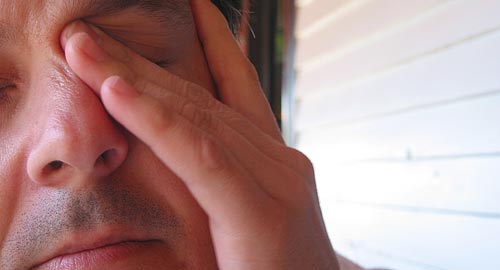 It’s that time of year. Allergies are rampant. Daylight hours are longer. Kids’ activities are ramping up in preparation for the end of the school year. This creates a perfect storm of stress in the body, which almost always leads to sleep loss.
It’s that time of year. Allergies are rampant. Daylight hours are longer. Kids’ activities are ramping up in preparation for the end of the school year. This creates a perfect storm of stress in the body, which almost always leads to sleep loss.
If you’re a natural health lover, you probably aren’t going to pop an Ambien to remedy your sleep issues. I’ve got some herbal, diet, and exercise options to help you rest well.
It’s important to note that herbs are drugs, and therefore, you may want to consult your healthcare provider before using them. Consistent sleeplessness can indicate underlying conditions such as diabetes, depression, and heart disease.
Herbs

Valerian root is probably the most popular root you’ve never heard about. In most of Europe, it’s sold as an over-the-counter (OTC) sleep aid.
Pros:
It’s not addictive, which is a big problem with traditional sleep aids.
It doesn’t require a prescription and is readily available over-the-counter.
Cons:
Valerian root doesn’t work for everyone. Although it’s popular, not everyone will respond to its hypnotic effects.
You need to be patient, as it can take up to three weeks to get into the system and begin to work. It also shouldn’t be taken for periods of more than three months at a time.
Like many prescription and OTC medications, it needs to be taken about an hour before bedtime. It won’t help you if you’ve already been tossing and turning for hours.
Side effects:
Valerian root may include mild indigestion, headache, heart palpitations, and dizziness. These tend to be mild in most people.
Contraindications:
Valerian root shouldn’t be taken with sedatives or antihistamines (or anything else that depresses the central nervous system). It also shouldn’t be taken by people with liver disease.
Chamomile is usually prepared as a tea, though you may find it in the form of buds of the flower, or (rarely) ground and placed into capsules. The tea is tasty and available at your local megamart.
Pros:
Chamomile is quite inexpensive (around $4 for a box of 16 organic tea bags at my store and on Amazon) and is available just about everywhere.
A side benefit is that chamomile helps soothe the digestive system.
Cons:
Because there hasn’t been any clinical evidence that chamomile actually “works”, it may be a placebo effect making people tired (or the effects of a ritual warm beverage). Either way, if it works, I’m good.
Side effects:
In people who are allergic to ragweed, chamomile may cause allergy symptoms.
Contraindications:
Chamomile should be avoided by those taking blood thinners.
This is where I’d like to make mention of kava. It’s an anti-anxiety herb that is surprisingly effective in aiding sleep. The problem is that there have been reports of liver damage as a result of taking kava, and therefore, the FDA recommends against taking it.
Now, the cirrhosis, hepatitis, and liver transplants required due to taking kava have been in countries outside the US (the number of cases is around 25), but kava has been banned in many countries nonetheless. If you desire to take it despite these cautions, I’ve got the 411.
Pros:
Studies and clinical trials have been promising, showing that kava is effective in calming anxiety, and therefore, helping people relax.
Despite the FDA’s warning, it’s still relatively easy to find in health food stores or (you guessed it) on Amazon.
Cons:
There is speculation that kava never has caused liver damage, but that it was preexisting. Still, it’s enough to make me recommend this method with caution, if at all. It’s definitely on the “last resort” list.
Side effects:
The side effects can be pretty severe. They include indigestion, headache, next-day drowsiness, skin rashes, and mouth numbness. Those who use kava for long periods and who use it heavily have exhibited kidney damage, abnormalities in their blood values, loss of muscle control, and pulmonary hypertension.
Contraindications:
Kava lowers blood pressure, so it’s not to be taken by those with low blood pressure, or those on blood pressure-lowering medication. It also decreases blood clotting, so people taking blood thinners (or who have bleeding disorders) need to keep away.
It may worsen the symptoms of Parkinson’s disease, and is a no-no for women who are pregnant or nursing. It is also a diuretic and can lead to dehydration if used in conjunction with other diuretics.
Relaxation
Insomnia Statistics
- There are three defined types of insomnia: acute, chronic, and transient. Additionally, there are several varying degrees of insomnia.
- Insomnia affects significantly more women than men.
Melatonin Facts
- Melatonin production is triggered by a part of the brain when one’s surroundings are dark.
- High doses of melatonin have been known to increase dream activity in some.
- Melatonin is deemed safe if taken in small doses for short periods of time, but long-term usage studies have not yet been performed.
“They” Said
- Sleep Aid–Natural Cures for Insomnia and Insomnia Herbs
- Natural Sleep Aids–What are the Best Natural Sleep Aids
- Natural Sleep Aids and Remedies
Visualization
Many people are calmed by conjuring images of a favorite place or scene. Far and away the most popular sort of environment seems to be a beach. My whole fear of open water says “no way, José” to that one, but whatever scene works for you is great.
The beautiful part of this technique is that you can add your other senses easily. You can add sounds of waves crashing on the shore, and keep the room a warm temperature (program the thermostat to go back down to a cool temperature for sounder sleep).
Yoga
Some kinds of yoga are better than others for relaxation. You’ll likely want to find a hatha class, which includes deep breathing, stretching, and savasana time at the end.
It doesn’t really matter what time of day you practice, though some people find that they can do it an hour or so before bedtime. If you don’t have access to a yoga class and don’t own any DVDs, there’s a good program on FitTV called Namaste Yoga. When I first started, it was how I practiced.
Progressive Muscle Relaxation
I actually learned this technique the first time in a yoga class. It’s essentially the progressive tensing and relaxing of the muscles in the body with as much mindfulness as possible.
It’s best to start in the feet and work up to the scalp. Clench the muscles of your feet tightly for five seconds, then release. Do the same for your calves, your thighs, your glutes, your forearms and abs, chest and biceps. Close your jaw and scrunch up your face.
Remember to clench only muscles, do not hyperextend joints (ie elbows, knees, jaw). Places people tend to forget are in the throat, between the eyes, and the scalp.
Diet:
Cut Caffeine
So many people are addicted to caffeine. I discovered that I was among that number when I was nursing my oldest (now 5). She wasn’t sleeping due to my consumption, so I cut it. I had a sleeping baby but a screaming headache. Now that I’ve been caffeine-free for years, the slightest amount of it makes my head spin.
Caffeine is highly addictive. You probably won’t realize the severity of the addiction until you wean completely off. For those of you looking to step down, I recommend an herbal “coffee” called Teeccino. If you’re not ready to leave caffeine behind, be sure to stop consuming it by lunchtime. It will benefit your overall health!
Cut Sugar
Refined sugar is evil, for sure. It’s overall one of the worst things you can put into your body. If you eat it within a couple of hours of bedtime, your blood sugars will drop during the night, which can cause you to stir. Caring for your blood sugar is one of the most important things you can do for your health.
It’s best to eat three meals per day to give your digestive system time to rest. Along with that, being done with food after dinner will help you sleep, as your system will have some down time instead of continuing to work.
Increase Magnesium
There are some pretty heinous things that can happen when your magnesium levels are low. However, more than half of us don’t get enough magnesium, and that can lead to sleeplessness. The good news is that there are easy dietary additions.
Legumes and seeds, dark leafy greens, almonds, cashews, blackstrap molasses, and whole grains are high in the mineral. If you find that you still have trouble sleeping, I recommend a great supplement called Natural Calm. It comes in several flavors, is easy to take, and is free of common allergens.
Other Ideas
Lavender Aromatherapy
Lavender is known for its calming effects, andscience is starting to agree with folk wisdom. It’s been found to lengthen total sleep time, increase deep sleep, and make people feel refreshed. You can place a sachet of buds under your pillow, or even make your own essential oil mist. It works quickly to help you rest.
Melatonin
Melatonin was popular with friends of mine on our trip to Russia last year. The ten-hour time difference can be brutal for people who aren’t used to international travel (or who, like me, don’t have a “no jet lag” policy).
Melatonin is produced in the body in the pineal gland. As a supplement, it’s believed to help by reestablishing our Circadian rhythms. There are also possible side benefits, such as protecting against Seasonal Affective Disorder (SAD) and reducing cluster headaches.
Children and nursing/pregnant mothers should not use melatonin. In addition, only man-made melatonin should be taken. Do not use the (rarely found) melatonin from ground cow pineal glands due to the possibility of contamination.
Practical Solutions
A few final thoughts on overcoming sleeplessness include making sure you set a consistent bedtime and rising time. It’s a bummer to get up at the same time on weekends as you do during the work week, but it helps your body establish sleep/wakefulness cycles which lead to better rest.
I like to make my to-do list before I go to bed for the following day. It allows me to take all those thoughts that are rattling around in my head and put them on paper, where I’m confident I won’t forget them. I keep a pad by my bed, just in case I sit bolt upright at midnight with an idea or something I’ve forgotten.
I also use a memo pad to record dreams that I want to study a little bit more first thing in the morning. By mid-morning, I’ve forgotten most of my dreams, and then I have to dream something similar again to get the lesson. So frustrating!
It may take a combination of several things to get your sleep cycle in proper rhythm. Be sure to keep records of what works and what doesn’t so that the next time you face a sleepless night, you can get right to a solution!
